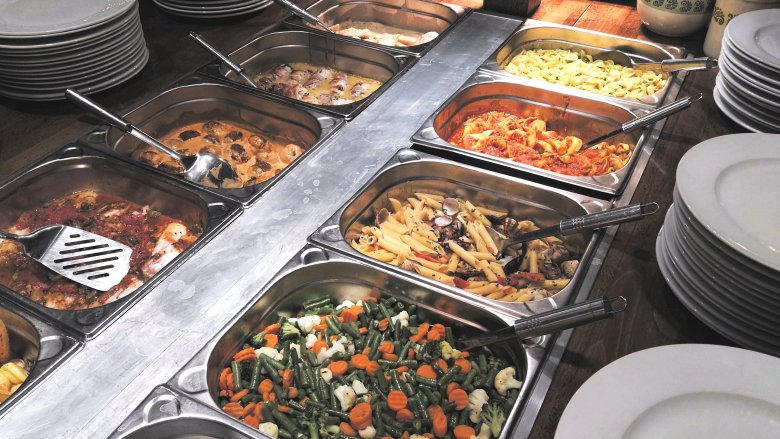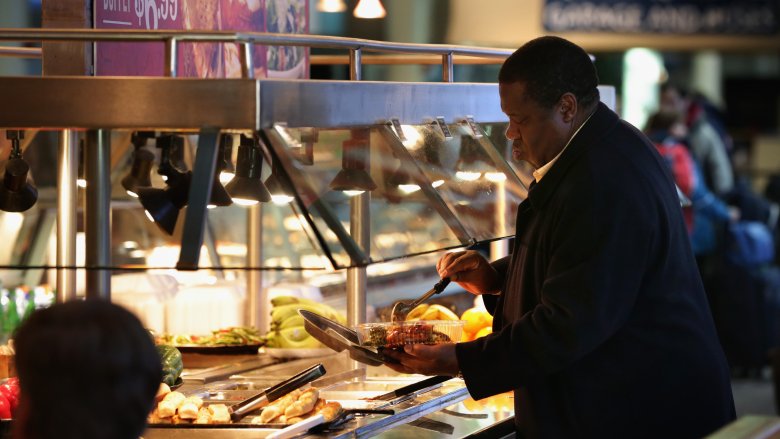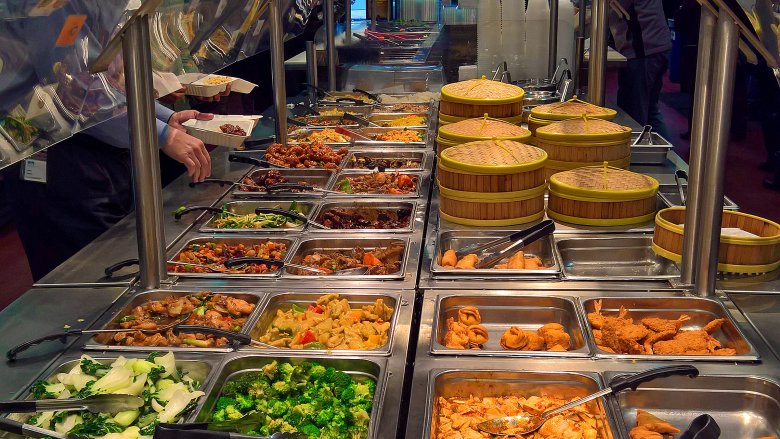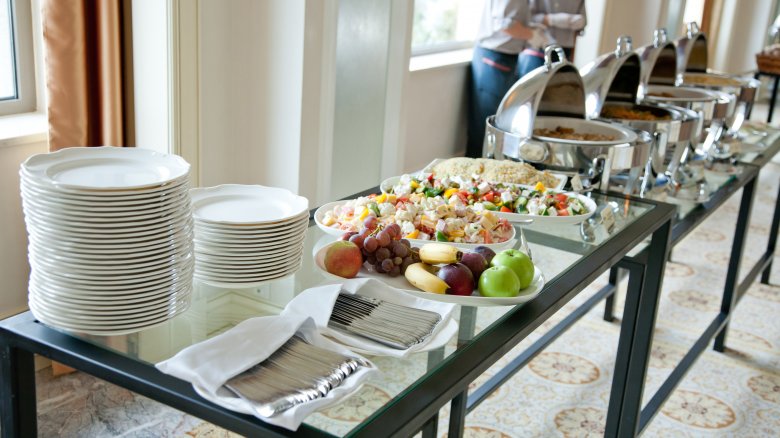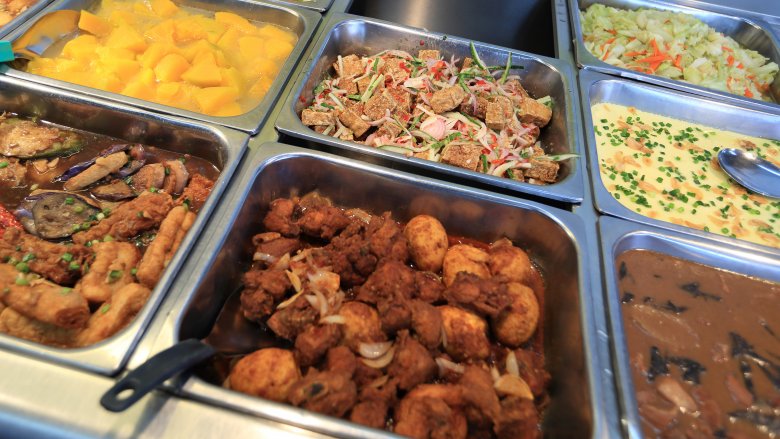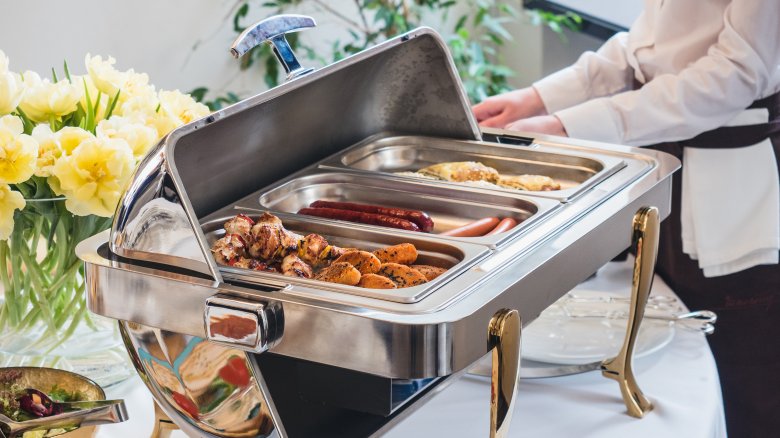Signs You're At A Bad Buffet
Buffets, all-you-can-eat or otherwise, are a staple of American cuisine. Call it a holdover from our American Revolution days and desire for independence, or chalk it up to the nostalgia of feeling like we're in school again, Americans love serving themselves food from long queues where everything is on display. For the all-you-can-eat variety, there's also probably something tied to our "pull yourself up by your bootstraps" mentality that's somehow associated with getting our money's worth.
To be honest, it doesn't really matter why; Americans just love us some buffets. One of my very first jobs in high school was working at a combination steakhouse/buffet, so I've seen it all. I also know what makes a really good buffet and, conversely, what should make you turn right around and head back out the door. These are the signs you're at a bad buffet.
There are no sneeze guards
Even if you didn't realize this is what they were called (or you've always called them "food shields"), you've definitely seen sneeze guards before. They're the pieces of glass you have to look through and reach under to get to your food at a buffet. They're designed to, you guessed it, protect the food if you sneeze. They also protect the food from customers' hair (and pretty much anything else, like bugs, dirt, etc.) from falling into it.
The regulations for sneeze guards vary from city to city and state to state, but the National Sanitation Foundation has some general guidelines that should be followed. According to their guidelines for self-service food (like restaurant buffets), the maximum distance between the bottom of a sneeze guard and the top of the counter below it should be 13 inches. If you're at a buffet where the sneeze guards are nonexistent or very small, you can just about bet that the food is contaminated pretty regularly.
Additionally, sneeze guards are required by law and have been around since the late '50s according to the Smithsonian magazine. So if the buffet you're at doesn't have one, who knows what other rules the buffet might be skirting. Definitely not worth the risk no matter how great you heard their mac and cheese is.
Utensil shortage
Buffet utensils are pretty gross in general. Think about it: Everyone who goes up to the buffet touches all the same utensils. And how many of those do you think washed their hands before they started serving themselves? Eww.
While the utensils used to prepare food must be changed out every four hours at a restaurant, Sydney Ross Singer from the Institute for the Study of Culturogenic Disease shared with Food Safety News that there are no explicit regulations on how often serving utensils must be changed out. This means the same tongs could be in the salad for an entire day. The exception to this is if utensils are dropped on the floor. In that case they should be replaced immediately.
But how many times have you seen someone wait patiently for tongs to be replaced at a buffet when there's a shortage because one fell on the floor and was placed in a nearby bus bin? Typically customers just reach for the tongs in another dish or (far worse) use their hands to grab food. At best we're talking cross-contamination from one food to another (allergy sufferers beware!) and at worst we're talking bacterial contamination from people's hands.
Fewer dishes, more illness
Like a shortage of utensils, one of the things you don't want to see at a buffet is a shortage of plates and bowls. This is because using a fresh plate for subsequent trips up to the buffet isn't just good etiquette, it's a safety issue. Good buffets either offer adequate plates at the start of the buffet line or have servers who regularly come around and offer fresh plates. Some buffets avoid this thinking they'll save money because you won't want to wait around for a second plate, but what you end up with is contaminated food.
Think about someone coming to the buffet with a cold or the flu. Even if they aren't feeling it yet, they could still be contagious. And even if the buffet has top notch sneeze guards, contamination from a dirty plate is still a real concern. Imagine if that person with the cold or flu wants seconds and takes their now-contaminated plate back up to the buffet line. When they put more food on their plate, the utensils touch the contaminated surface of their dirty plate then go right back into the remaining food. Now everything is contaminated.
Employee disappearing act
By their very nature, it would seem logical that buffets employ fewer people than other types of restaurants. After all, how many people does it take to keep food stocked on a buffet line? You'd be surprised, especially if there are a lot of different food options.
That's because not only are cooks in the back keeping the next round of a dish coming, there are also people who are then bringing that food out to replace empty containers. Sometimes these food runners are the same people who are making the food, which means a lot of time management. If you notice that the whole time you're getting your food or eating, you don't see a single employee coming to change out food, that's a red flag. It means the food is just sitting out on the buffet for long stretches of time, getting dried out and crusty. Not what I'd call appetizing.
Giant tubs of food
Sometimes restaurants deal with an employee shortage by putting out giant tubs of food. The apparent thought process is that large, deep pans will stay full for longer, allowing employees time to manage other tasks. While there are wells for heating and cooling beneath the pans at a buffet, it's still hard to keep food at a safe temperature for long period of time. It's also a lot easier to keep an entire dish at the same temperature when the pan is small.
This is why the Minnesota Department of Health (among others) recommends shallow dishes for keeping hot food hot and cold food cold at a buffet. Sure, it can get annoying when food runs out at a buffet and you have to wait for the dish to be replaced, but wouldn't you rather have that than bacteria growing on food that isn't being kept at the right temperature?
Servers with no service
Unless the restaurant you're at is like the one where I worked and works double duty as both a buffet and full-service restaurant, the servers don't have too many jobs: refill drinks, bring plates if they aren't up on the bar, and clear dirty dishes. That's why it's super frustrating if you're at a buffet and need something, but there's no server to be found.
If you're sitting at a table with an empty glass in front of you for a long period of time or return to your table to find all your dirty plates still there, that's a sign of a bad buffet. Sure, everyone in the service industry messes up sometimes or gets so busy that they fall a bit behind, but if you're having consistent service issues, particularly if the restaurant isn't very busy, take notice. It either means the servers are also working in the back of the house (which could be a sanitation issue) or the restaurant cares very little about the quality of its employees. Neither bode well for the food you're eating.
Restaurant by week, buffet by weekend
While the restaurant where I worked was both full-service and a buffet all week long (before you ask, yes people who didn't order the buffet stole food off the buffet all the time), some restaurants only offer a buffet on the weekend. While this isn't inherently a bad thing, and can be a great way for a restaurant to break into the brunch scene in particular, if a restaurant only has a buffet once a week, be on the lookout for recycled food.
If you've eaten there before and had steak then on the buffet you see strips of steak for making sandwiches (or steak and eggs for a breakfast buffet), know that it's probably an attempt to get rid of food that's right on the verge of spoiling. The food could still be perfectly okay — after all, who among us hasn't repurposed leftovers into another dish at home? That said, when you're making a dish at home, you know exactly what's going into it and just how close to spoiling your food is. At a restaurant, you don't really know how close it is to being over the edge. What, you thought the chicken pot pie was made with fresh chicken? The same goes for restaurant "specials," but that's an entirely different article.
Not making the grade
Lucky for us, we live in an age where sanitation is taken seriously. This means that restaurants are regularly inspected to ensure they're on the up and up. The Food and Drug Administration publishes a Food Code every four years (previously every two) that outlines best practices for restaurants and other retail food establishments. That said, the Food Code doesn't have to be followed uniformly and sanitation regulations vary from state to state and depend on the type of restaurant.
It can be confusing, but these days it's fairly easy to find out whether or not your favorite buffet has any serious violations in its past. While many states require restaurants to display their sanitation scores, this doesn't reflect any violations that were discovered and ultimately corrected. Because restaurant inspection doesn't happen daily, looking for trends in violations at a particular restaurant can give you an idea of if the buffet you're frequenting has some issues. Many local health departments have searchable databases for restaurant sanitation scores, along with a history of violations and indications of whether the violations were critical. If your favorite buffet consistently isn't making the grade, it may be time to find a new one.
There are UFOs
In this context, UFOs refer to unidentifiable food options, which are never a good sign at any kind of restaurant, but especially a buffet. At least a sit-down restaurant offers a menu that lists all the options available to you. If you have questions about specific ingredients, you can usually find out by asking if they're not explicitly stated. But at a buffet, things can get tricky.
Not all buffets have a list of what's being offered for the day and sometimes it's just really hard to tell. Is that a tray of lumpy mashed potatoes or a baked mac and cheese made with white cheddar? Is that fish or chicken? If you're at a buffet and can't tell what a food is (and there's no clear labeling), just run.
